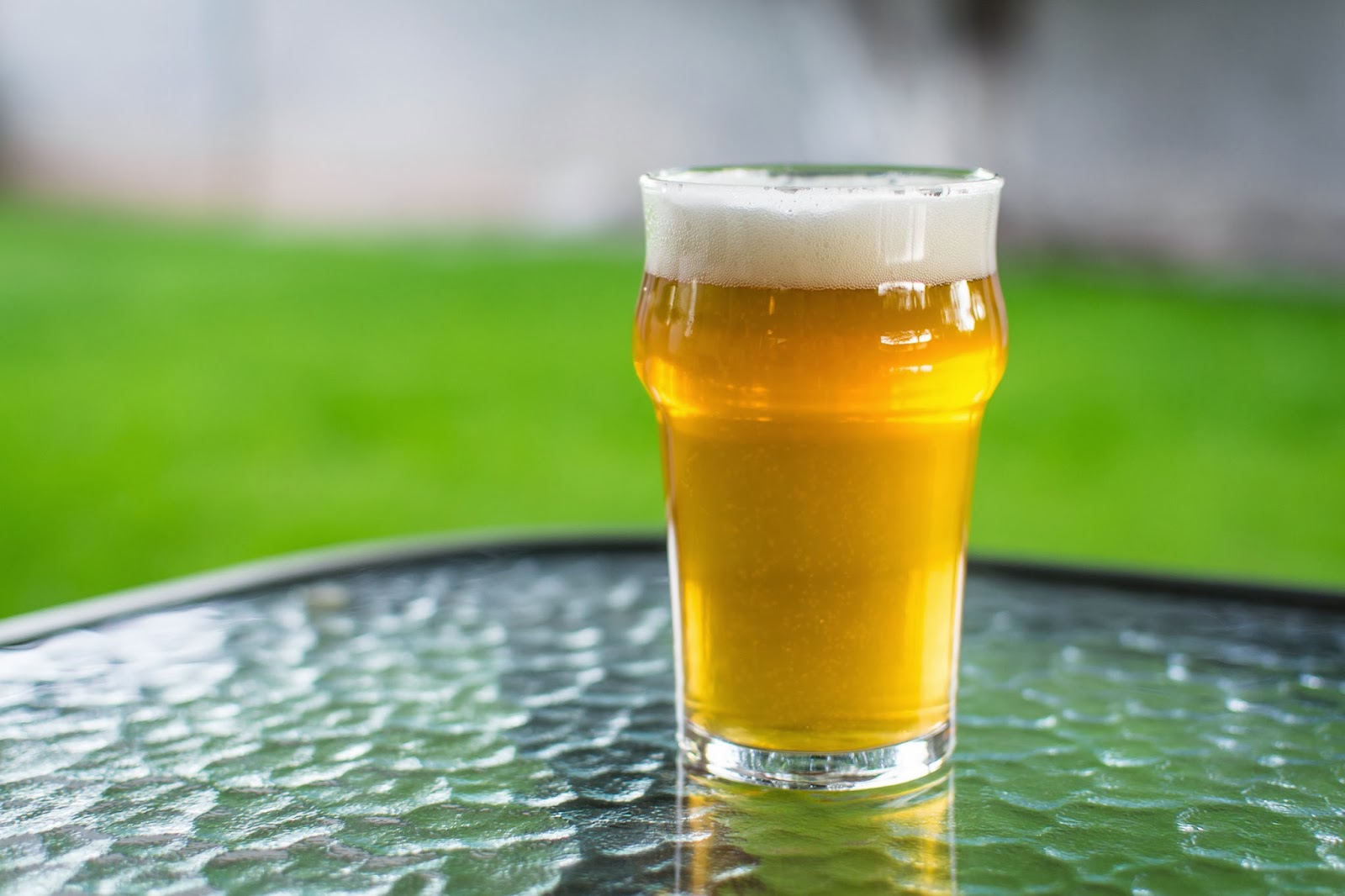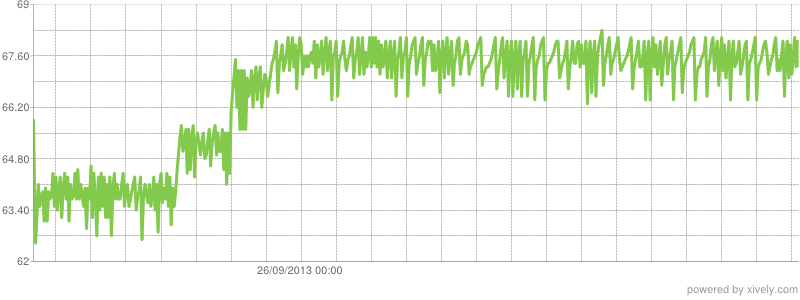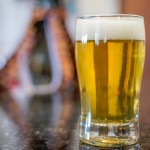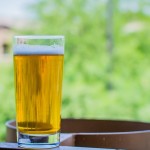Micro Pale Ale 2.0

I’m on a quest to brew a really tasty low gravity Pale Ale. I want something in the 1.035-1.037 range that has the hop quality of an IPA. To be perfectly honest, this recipe has been harder to put together than I thought it would be. Last time I brewed this, it was a little rough around the edges. I’ve since tweaked the recipe some, and we’re giving it another go.
I didn’t make too many drastic changes. I’m throwing a pound of C20 at the recipe to hopefully increase the body, and give the beer more drink-ability. I’m also dropping the Nelson Sauvin, as I didn’t like what it brought to the table. Aside from that, I kept everything else the same. The goal was to have the FG come in around 1.010-1012 for a 3.2-3.5% ABV beer.
Prior to brewing this batch, it’s been a mad rush to finish the beers for the wedding. Our weekend was surprisingly not too busy, so I squeezed this batch in so I’d have some beer once we got back from California.
The Summer heat finally broke here in Phoenix, and it’s been absolutely fantastic out. Highs in the low 90s with lows in the 70s. Fall is finally here, and brewing outside feels great. For those that live in cold weather states, we love Fall like you love Spring. Anyway, I mashed this for 60min at 155, then boiled for 60 before a short five minute whirlpool. After that I chilled it down to 62, and pitched a single vial of WLP090.
Brewed: 09-21-13
Kegged: 10-9-13
OG: 1.037
FG: 1.008
ABV: 3.8%
IBU: 27
6 Gallons
5lbs 2-Row
1lb Munich
1lb C20
8oz Carapils
Mash @ 155*
6g Apollo @ 60
1oz Falconer’s Flight @ 15
1oz ea Amarillo & Centennial @ 0
WLP090 -San Diego Super Yeast
Dry Hop: .75oz ea Amarillo/Centennial + .25oz CTZ
This fermented out a bit too well, as I was surprised to see the FG at 1.008. I’m severely underestimating how well these low gravity beers attenuate. I tossed the hops straight in the primary for a week, and then crashed the beer 24hrs before racking it to keg.
I’ve had it on tap for just about 2 weeks, and it’s coming along. Appearance is a hazy pale orange color with a very nice head for a low gravity beer. Aroma is mostly hops. Sweet citrus with lots of grapefruit. It has a squirt soda kind of thing going on. There’s a little malt underneath that, but the aroma isn’t overwhelming by any stretch. The flavor is pretty similar, some sweet hops, and mild malt flavors. Mouthfeel is fairly thin and watery despite the fact it’s well carbonated.
I’ll be perfectly honest, crafting this recipe has been far from a slam dunk; it still needs some work. This batch is by all means a decent beer, but for lack of a better work, it’s pretty blah. There just isn’t enough flavor going on, and the mouthfeel doesn’t help the beer’s case. So where do we go from here? I’m going to up the carapils and the mash temperature to increase the dextrines. I’m also thinking about adding a small amount of rye for some beta-glucans, maybe about 10% or so. Not enough where the rye is that noticeable, but hopefully enough to add more body. I’m also going to throw in some hops with more character. I’m thinking adding some Citra and increasing the CTZ will give the beer a little more of a leg to stand on.
So stay tuned, as this is a recipe I’ll be continuing to work on over the next few months. Although, this beer is proving to be elusive, I hope it doesn’t turn into a unicorn for me.





Have you considered using a less attenuative yeast strain, something english, that would leave more body left in the beer?
When I brewed an english mild, which isn't the same beast, it started at 1030, and ended at 1.011, with a 159 mash temp.
Best of luck, I'm eager to get something like this nailed as well.
This is similar to a quest I have for Panic. I don't know if you've had Moon Man from New Glarus, but it's phenomenal and somewhat similar to what you're trying to do. Very low bitterness, amazing hop flavor and aroma, perfect body, and you could drink pint after pint. I think the alcohol is probably closer to 5%, so not meant to be a LOW alcohol beer, but very, very sessionable. It fits our Midwestern sensibilities perfectly.
Have you thought about trying your recipe with an English strain fermented at maybe 64 degrees or so, to avoid too much "Englishy" flavor? I've been using Wyeast 1469 West Yorkshire quite a bit. I did a split batch of my pale ale, one with California Ale, one with West Yorkshire.
The West Yorkshire just seemed to fill out the palate a bit more. A little more malt flavor, a little more support for all the late hops I've been adding. Really nice, and convinced me that this will probably be my house strain. I also use flaked wheat quite a bit, about 10% or so, in my pale ale recipe.
It seems at these lower gravity, high hop aroma/flavor beers, the standard neutral American yeasts aren't quite hitting the bullseye for me. I've never used the San Diego yeast, but from what you've written, it seems to be even more neutral. I think these beers just need a bit of hoisting in the middle of the palate, if you know what I mean.
Can't wait to see what you finally come up with!
Cheers,
Gary Gulley
Panic Brewing, Chicago, IL
facebook.com/panicbrewing
Great minds.
I have, but I really want to find a way to use WLP090. The other reason I like brewing session beers is they are an easy way for me to culture yeast for future batches.
I haven't had that one, but most of the commercial examples I've had have been in the 4-5% range, which is bigger than I want to go. Lagunitas Daytime IPA is a great example.
I think I'm going to try to make it work with an American yeast. It's just going to take some more trial and error.
Hi Scott, I have a similar recipe that benefitted from a pinch of Simcoe at flameout and then adding 2 ounces of Santiam into the keg, using your SS mesh thingy for 4 days or so. That gives it more of a rolling flavor sensation, which seems to translate to the complexity that keeps it interesting. I wouldn't go more CTZ in this case.
Have you considered changing the base malt to something british like maris, golden promise, or pearl? Even 2.5 lbs of one of those will give you more malt flavor. I'm not sure what C20 you're using, but going british there could also boost the malt depth and complexity. I'm a big fan of Fawcett pale crystal. I know you have the carapils in there, but you could add a touch of flaked barley or flaked rye to add some creaminess. These things accompanied by a 157-158 mash temp should get rid of the watery taste, and the WLP090 should still take it down to 1.010-1.012. I like your idea of adding Citra and upping the CTZ in the dry hop. The body the english malts will add should allow you to up the IBUs a bit and maybe hop burst, but I understand if you don't want to change too many variables at a time. Personally, I'd start with some golden promise and a higher mash temp for version 3.0 and go from there.
Ya, I'm with you on a lot of these points. I'm already planning to switch C20 out for Carastan. I'm a big fan of English crystals, and I try to use them wherever I can.
I was planning on using malted rye, but flaked rye isn't a bad idea. As for the base malt, I'm really lazy. I buy malt in bulk, and I try to use american 2-row for everything I can. It's probably counter-productive, but I'm going to really try to do without a british base malt if possible.
I think I'm going to see what more carapils, some rye, a higher mash temp, and some punchier hops does for the recipe, and go from there.
I assume you plan on using the 90 for a big DIPA or something else that needs that beast?
090 is the Super San Diego strain. It's not the 099 which is the Super High Gravity strain.
090 is very similar to 001. It ferments a little quicker and flocs faster, but you can basically think of 090 as 001. Just a clean American yeast. I'm using it almost exclusively now, so it's nice to brew session beers with it, as I can pitch a vial directly in, and then re-pitch the slurry into the next couple batches.
Hi Scott, big fan of the blog. Have you had Drake's 1500? It seems to be very similar to what you're trying to achieve here. I liken it to a Pliny ultra-light. My last batch was a clone of this, and turned out great. I too was looking for a respite from the high ABV double IPA's I've been drinking lately.
Thanks.
Ya, I had it a few months ago when I was in Cali. It is really good, but it's a whole different animal that what I'm brewing. I think 1500 is 5.5% and I'm shooting for 3.5%. This beer would be a slam dunk if I could throw another 15 gravity points at it, haha.
I do have another recipe in the works more similar to 1500 though. I want to try to brew something that tastes like stone's Enjoy By, but in the 5.5% ABV range. Basically an Enjoy By Pale Ale. We'll see how that one turns out.l
I think I mentioned it in your Scottish 60/- recipe, but I really think that grist would make a great sessionable hoppy beer! I guess you are trying to keep the beer the lighter color though?
Looking over your recipe I am kind of with the other guys here. I'd go with English malts as well. I have a BIAB recipe I've been tweaking and it's 50/50 MO and american 2 row.
I doubt you've had anything from snipes mountain brewery (small brewery that barely makes it out of washington), but they were one of the first session IPA's I've ever had. Their "little chief" recipe was sent to me by the brewer.
He shoots for 1.042 and ferments it down to 1.011, so slightly higher at 4%.
He uses 78% 2 row, 11% cara-pils, and 11% caramel wheat malt. Mashed at 156.
He also uses warrior and simcoe for first wort hops, and then small additions of simcoe throughout the boil, at flame out he hits it with simcoe, citra and ahtanum. For dry hopping he uses aggressive amounts of citra and mosaic (2oz each for 5 gallons). I think the citra/mosaic gives it a really great nose. I used WLP001 for this, so you're 090 should work just fine too.
This beer is still pretty thin, but it's quite drinkable. Not sure if you can glean anything from this, but I figured I'd throw it out there.
–Chris
Ya, that definitely sounds like more what I'm going for. I'm probably going to get a little more exotic with the dry hopping next time around.
This comment has been removed by the author.
I think it's going to be a bit of a challenge to keep the FG higher if you continue to use WLP090 as the yeast. I'd recommend either mashing higher ~158F or switching to a lower attenuating yeast (like WLP002) and fermenting cool to avoid the esters. I suppose you could also cold crash the yeast out once you get close to the FG you want, but you'd have to keep a close eye on the gravity readings!
Otherwise, I love seeing this kind of experimentation and am eagerly following your results 🙂
Maybe 8oz of torrified wheat. It can be a bear to clear but it would add some body and not add too much to the gravity.
If you really want to amp up the flavor, then use more hops, move them all to flameou,t and do an extended hop stand/whirlpool. The tough part will be dialing in the IBU's you want, but hop stand bitterness contribution is much smoother than a traditional 60-minute bittering addition (think FWH) so that should be a bit forgiving. You could even wait until your temps come down a bit to lower your utilization and allow you to stuff more hops in there.
Also, I'd dry hop the crap out of it. I'm currently using 1-2oz per gallon of dry hops in my IPA's and you actually start getting flavor from it at that point, not just aroma.
And definitely push your mash temp as high as you can. On a beer this small 162F is what I'd be shooting for.
Oh, trust me, I'm definitely all about big whirlpool and dry hop additions. It just really takes over a beer this small. (I've made that mistake in the past.)
I need a little more malt backbone before I can throw more hops at it. At a certain point it tastes like hop tea, and at this gravity, it happens quick.
I'm definitely going to mash very high next time. I'm going to try 160, and see what that yields.
I dry hop with 6 oz in my micro IPA and have a huge flameout addition and it doesn't over take the beer at all. But like you said, you definitely need more malt back bone. Maris Otter, Victory, Munich, and some darker crystal, a less attenuative yeast, and mashing higher should all give you a much better malt backbone to throw hops at. My 4% micro IPA has just as much flavor as a DIPA and definitely doesn't come off as a hop tea.
Scott – maybe I missed it before but could you run through your O2 regemine? Using disposable O2 tanks? Time for small beers vs big beers?
Mind sharing that recipe?
Disposable O2 tanks with a wand from Williams brewing. I hit high gravity beers with 90-120sec, normal gravity for 60.
Those are numbers for WLP090, I find it a little more oxygen hungry. WLP001 was always fine with 60sec
Ya, I'd be really curious what kind of specialty malt %s you're working with. Thanks in advance!
Not at all. I use 80% Maris otter, 5%victory, 5% flaked oats, 5% carapils, and 5% c120. I know the c120 sounds out of place in an IPA, and it usually would be but I really liked what it did for my micro ipa, doesn't come off sweet or too caramel tasting.
Oh and if you are interested in the other specifics tommy, I do 20 ibu magnum as fwh, 20 ibu ctz @30min, and flameout 2oz centennial and 2oz simcoe. The galaxy/nelson enjoy by dry hop, mash at 158, English yeast or my favorite yeast for this one has been Wy1450 for a nice big mouthfeel. Low carbonation is essential also.
One more thing you could try for more malt flavor is simply toasting a pound or two of your American 2 row in the oven at 350 for 15 to 30 minutes. I buy in bulk as well so I do this when I want more of that nutty British flavor going on. Hope the next batch gets you closer to what you're looking for.
One more thing you could try for more malt flavor is simply toasting a pound or two of your American 2 row in the oven at 350 for 15 to 30 minutes. I buy in bulk as well so I do this when I want more of that nutty British flavor going on. Hope the next batch gets you closer to what you're looking for.
Do you crank the regulator fully open? How many brews do you usually get from one tank?
I only ask because I finally got a regulator and stone, but I ran through the entire $10 O2 tank after 60 seconds fully open.
Oh, no, definitely not full open. I turn it on just enough to see bubbles at the surface of the wort with the wand at the bottom.
I get probably 15 batches per bottle or so.
There was a Basic Brewing Radio podcast recently with the owner/brewer of Notch Brewing that covers session beers quite well. Lots of good insight.
I'll definitely have to check that out. Thanks!
Try using a US or Canadian 3-5L pale ale malt as the base malt, it makes all the difference. Or stick with the 2-row
but use 20% English pale ale malt. I brew 1.035-1.040 religiously….pale ale malt makes all the difference. Franco-belg pale ale is quite lovely too.
cheers!
[…] 5-6 months later I brewed my second stab at this style. I added an entire pound of C20 and 8oz of Carapils, but kept the mash temp […]